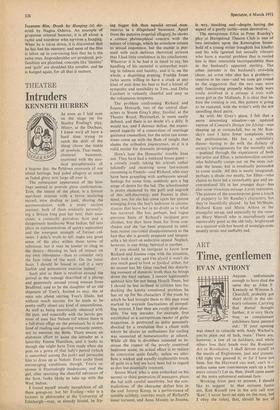ART
Time, gentlemen
EVAN ANTHONY
Anyone unfortunate enough to have died the same day as John F. Kennedy or Winston S. Churchill, probably got short shrift in the obi- .tuary columns. Carrying that dismal thought further, it is very likely true, as complainant exhibitors have pointed out: 'If your opening was timed to coincide with Andy Warhol's, you're plain out of luck, mate.' There are, however, a few of us holdouts, and while others lose their heads over the Russians' Art in Revolution, I shall devote myself to the merits of Englishmen, past and present. (All right you guessed it; so far I have not been, but the Hayward can wait, can't it— unless some new contretemps seals up a few more rooms?) Let us, then, dwell upon some of the more ephemeral national fare.
Working from past to present, I should like to suggest to that eminent fanta- sist, Ken Russell (we in the arts call him 'Ken'; I never have set eyes on the man, but I obey the rules), that, should he tire of tossing the salad of the music world, he could do worse than direct a glance or two towards the pain and passion of the artist.
The Gallery Edward Harvane in Bourne Street (which is behind the Royal Court Theatre) inspires the idea with its current
show, The World of Lytton Strachey. Here we have Lytton, illuminated through the
art of his playmates: Dora Carrington ('As she leant over him,' to quote Michael Hol- royd, 'Lytton suddenly, quietly, opened his eyes and looked at her. She seemed to be- come hypnotised and fell, there and then and for the rest of her life, violently in love with him'), Henry Lamb, Roger Fry, Vanessa Bell, Mark Gertler and others. The exhibi- tion of the work of these dear friends is evo- cative of the Bloomsbury set era and post- epoch; as such, it offers an abundance of charm. Many famous heads are on view, and for real aficionados, good news—some are for sale.
The heretofore neglected Mark Gertler showed up, yet again, stacked against the walls of a room in the galleries of Agnew's
in Old Bond Street. His paintings were en Passant, heading for the Minories in Col-
chester, where this retrospective exhibition of his work opens on 6 March. Londoners will have to plan an outing if they cannot wait until the show returns to town, properly hung, at Morley College, on 15 April.
Gertler cuts a romantic figure as an artist —passionate love affair, tuberculosis, neglect, recognition, and finally, in 1939, suicide.
Starting life in the `ghetto-like atmosphere of the East End Jewish community before the first world war', Gertler emerged as a peri- pheral figure of the Bloomsbury set. The work by which we may judge him now is an interesting and representative collection of post-student, experimental, and later period works. The early family scenes and Portraits of his mother are warm and quite lovely, painted in what I call a 'refined style' When contrasted with the later work. The middle period is under-par Cezanne, and the later pieces are rather heavy and oppres- sively coloured, despite the brightness of the Palette. The later works, considered as ex- Periments, are adventurous, if relatively un- successful. I look forward to seeing them again, properly hung, but there is something to be said for looking at work in a warehouse atmosphere.
At the Hamet Gallery in Cork Street, I suffered a panicky moment as I admired a Painting and saw it sold from under my very
nose. There may still be a few left, folks, but l doubt it. The day I went to see the exhibi-.
lion of William Roberts's work—a retrospec- tive collection, covering more than half a century—it seemed as though those enviable marks of distinction (and money), the round red stickers, had descended like a shower of confetti.. Yes, Roberts is definitely 'in,' and Whether he likes it or not, I suspect he's a verY good investment indeed. His stuff is very attractive and humorous. Many of the Paintings look not unlike designs for mosaics that should grace the walls of a super new office block or perhaps a gymnasium hailing the humanity of the common man (and Woman), Roberts's figures are solid, Leger- like in form. It will very likely take all the
Muscle of the robust male dancers to lift the ladies in their inner-tube tutus. The People are people's people. if you know what I mean; football players, baseball players, chess players, errand boys, munitions work- ers: stylised and amusing. They emerge as Patterns as much as people, richly and deco- tatively (but not garishly) coloured.



































 Previous page
Previous page